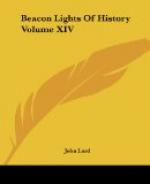At length on reaching the age of seventeen he became stirred with military ambition, and, dissatisfied with his present prospects, he left his position with its opportunities for the future, and entered the Swedish army as ensign of a regiment of Field Chasseurs. This regiment was famous for its rifle practice, and Ericsson was soon one of its most expert marksmen. The routine of army life was, however, far from being sufficient to satisfy the uneasy genius of John Ericsson, and we soon find him engaged in topographical surveying for the Government, and so rapid and industrious in his work that as the surveyors were paid in accordance with the amount accomplished, he was carried on the pay rolls as two men, and paid as such, in order that the amount which he received might not seem too excessive for one individual. Even this was not sufficient to exhaust his energy, and about this time he conceived the idea of publishing a book of plates descriptive of the machinery commonly employed in the mining operations of his day. To this end he collected a large number of sketches which he had prepared in his earlier years, and made arrangements to take up the work of preparation for publication. The drawings selected were to be engraved for the book, and, nothing daunted by the undertaking, Ericsson proposed to do this work himself. After some discouragement the engraving was undertaken, and eighteen copper plates of the sixty-five selected, averaging in size fifteen by twenty inches, were completed within a year. In various ways the project met with delays, and it soon became apparent that the rapid advance in the applications of machinery to mining would render the work out of date, and it was at length abandoned.
At about this time Ericsson seems to have taken up seriously his work on his so-called “flame-engine,” certain experiments made by his father having suggested to him the hope that a source of power might in this way be developed which would be more economical than the steam-engine. At this point we see entering into Ericsson’s life an idea which never left him, which controlled much of his work in mid-life, and which attracted no small part of his attention throughout his closing years. This idea was the discovery of some form of heat-engine which should be more economical than the steam-engine, especially as it was in his day. The flame-engine idea grew rapidly, and soon absorbed his chief attention. Military life now lost its attraction, and in 1826 obtaining leave of absence he left his native land and turned his face toward London, doubtless with the hope strong within him that a substitute for the steam-engine had been found, and that his future lay secure and easy before him.




